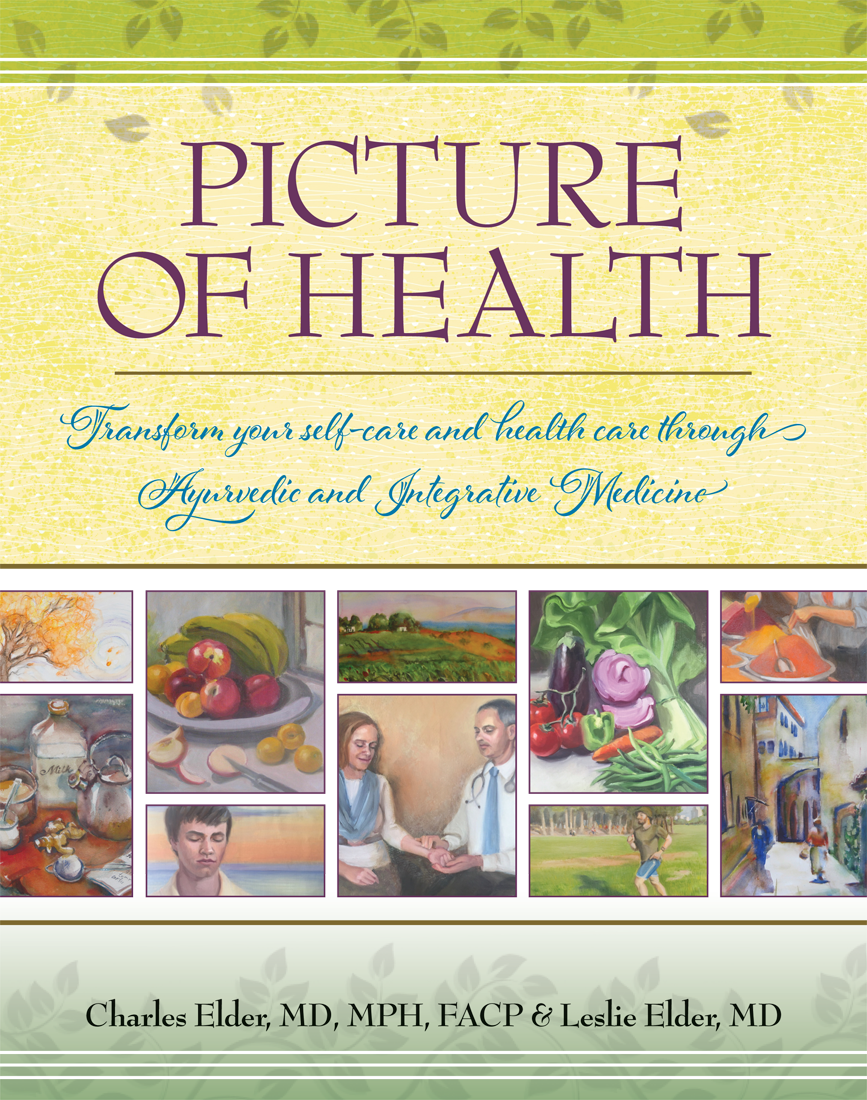Picture of Health now available from the Permanente Press
Picture of Health: Transform your self-care and health care through Ayurvedic and Integrative Medicine provides a succinct, practical , user friendly manual for patients seeking to improve their health by integrating the best of both holistic and conventional medicine. Drawing upon the authors‘ decades of experience as both primary care and integrative medicine physicians, the book explores basic concepts of Ayurveda, as well as other popular complementary medicine approaches, in a a succinct yet authentic way while remaining compatible with the conventional medicine culture. Patients learn how, and why, to incorporate diet, daily routine, exercise, herbals, meditation, and other modalities to enhance the usual medical care in order to reverse disease and maximize wellness. The book includes case reports, scientific references, disease specific guidelines, inspiring illustrations, recipes, and lots of practical ideas and tips for people who are ready to take the next step toward ideal health.
Section 1 of the book expands upon a curriculum originally created for the group Complementary and Integrative Medicine clinic offered at Kaiser Permanente Northwest in Portland. These chapters provide an overview of basic concepts of Ayurveda in a way that can be easily understood and effectively applied by westerners. Topics include guidelines for proper digestion, how to select foods based upon one’s individual constitutional type, and fundamentals of exercise and daily routine. The material includes detailed menus and recipes geared toward busy people who want to cook healthy meals and eat well.
Section 2 includes an overview of popular approaches and current topics in the field of complementary and integrative care, including mind-body medicine, herbal supplements, placebo effects, and whole medical systems, The text provides readers with straightforward clinical advice coupled with insightful analysis of the contemporary bio-medical literature. For example, herbs and supplements have become a big business. What is the appropriate role for herbs and supplements in maintaining health and treating disease? Patients and physicians alike must consider many factors, including safety, efficacy, cost, product quality, and the potential for herb-drug interactions. In Chapter 8, entitled “Drug, supplement, or food?” the book provides an up to date evidence informed review of the pertinent issues. Readers learn about which products are likely safe and effective, which are not, and why. This chapter also explains how practitioners from Ayurveda and other complementary medicine systems think about and prescribe herbs and supplements in different ways. Readers thus gain both heightened awareness and understanding as well as practical advice.
Section 3 emphasizes protocols and resources to support each patient’s individualized therapeutic program, based upon specific health concerns. Topics include gastrointestinal disorders, chronic pain, cancer, women’s health, and cardiovascular disease. For instance, although the medical management of chronic musculoskeletal pain can be challenging, fortunately we can offer many compelling complementary medicine approaches. The book reviews the evidence supporting the use of a number of proven approaches to pain management, including acupuncture, chiropractic care, and the Alexander Technique. In addition, Chapter 12, entitled “Managing with chronic pain,” provides self-care guidelines encompassing a number of additional compelling Ayurvedic interventions that many people may not be aware of. These include “ama pachana” (home detoxification procedures) as well as abhyanga (a daily self-administered sesame oil massage). The text includes not only the Ayurvedic explanation, but also provides an analysis of the underlying western scientific rationale for these practices.
This book will appeal to any number of audiences, including:
- Patients who are interested in complementary and integrative medicine approaches to help with managing their condition
- People who want to learn about healthy eating, and how to prevent and manage illness using diet
- Physicians, nurses, and other health care professionals who wish to learn more about complementary and integrative medicine, and/or who seek practical advice on how to integrate holistic approaches into their practices
- Health professions trainees, including aspiring physicians, nurses, acupuncturists, chiropractors, etc.
- Anyone interested specifically in Ayurvedic medicine
Although many publications are available on both integrative medicine and Ayurveda, this book offers timely contributions. The narrative reflects over 2 decades of clinical experience practicing integrative medicine and Ayurveda in a conventional managed care setting. How can healthcare organizations best integrate Ayurveda, acupuncture, and other compelling approaches in ways that are authentic, feasible, useful to both patients and physicians, compatible with the conventionl medicine culture, and scalable? This publication provides answers. This book empowers both patients and physicians to evolve beyond the prevailing confusion in the complementary and integrative medicine arena. In addition, material and themes throughout are augmented by inspiring and original watercolor and oil plates, by the co-author. Each reader will thus find inspiration, clarity, insights, and ideas that will enable him to relieve symptoms, reverse health challenges, and optimize wellness.
Picture of Health is now available from The Permanente Press.

